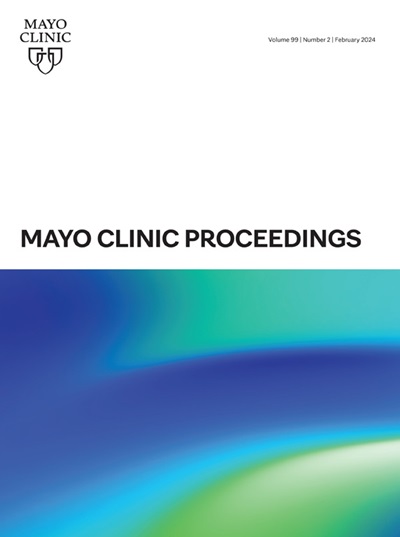Early Rhythm Control for Atrial Fibrillation in Patients With End-Stage or Chronic Kidney Disease
IF 6.9
2区 医学
Q1 MEDICINE, GENERAL & INTERNAL
引用次数: 0
Abstract
Objective
To investigate the benefits and risks of early rhythm control (ERC) in patients with atrial fibrillation (AF) and chronic kidney disease (CKD).
Patients and Methods
This population-based cohort study included 5224 patients with AF (58.2% male, median age 70 years) with end-stage kidney disease (ESKD; n=1660) and CKD stage 3 to 4 (n=3564), who underwent ERC or rate control between January 1, 2005, and December 31, 2015. A primary outcome consisted of cardiovascular death, ischemic stroke, heart failure–related hospitalization, and acute myocardial infarction.
Results
During a median follow-up of 3.5 years, compared with rate control, ERC was associated with a reduced risk of the primary outcome (hazard ratio [HR], 0.85; 95% CI, 0.74 to 0.98) without an increase in the composite safety outcome in CKD stage 3 to 4 (HR, 0.99; 95% CI, 0.86 to 1.13). In patients with ESKD, there was no difference between rate control and ERC in the primary outcome (HR, 0.97; 95% CI, 0.81 to 1.17) but an increase in composite safety outcome (HR, 1.29; 95% CI, 1.11 to 1.50). During follow-up, 65.0% of patients with ESKD and 57.3% with CKD stage 3 to 4 failed to maintain ERC. In the on-treatment (HR, 0.79; 95% CI, 0.62 to 0.99) and time-varying regression (HR, 0.81; 95% CI, 0.68 to 0.98) analyses, ERC was associated with a lower risk of primary outcome even in patients with ESKD.
Conclusion
Early rhythm control revealed a modest risk-benefit profile in patients with ESKD compared with CKD stage 3 to 4, with poor adherence to ERC playing a major role. Therefore, an approach tailored to renal function should be considered for choosing AF treatment strategies.

终末期或慢性肾病患者房颤的早期心律控制
目的:探讨早期心律控制(ERC)对房颤(AF)合并慢性肾脏疾病(CKD)患者的益处和风险。患者和方法:这项基于人群的队列研究纳入了5224例终末期肾病(ESKD;n=1660)和CKD 3 - 4期(n=3564),在2005年1月1日至2015年12月31日期间接受ERC或速率控制。主要结局包括心血管死亡、缺血性卒中、心力衰竭相关住院和急性心肌梗死。结果:在中位随访3.5年期间,与发生率控制相比,ERC与主要结局风险降低相关(风险比[HR], 0.85;95% CI, 0.74 - 0.98),没有增加CKD 3 - 4期的复合安全结局(HR, 0.99;95% CI, 0.86 ~ 1.13)。在ESKD患者中,发生率控制和ERC在主要结局上没有差异(HR, 0.97;95% CI, 0.81至1.17),但复合安全性结局增加(HR, 1.29;95% CI, 1.11 - 1.50)。在随访期间,65.0%的ESKD患者和57.3%的CKD 3 - 4期患者未能维持ERC。在治疗组(HR, 0.79;95% CI, 0.62 ~ 0.99)和时变回归(HR, 0.81;95% CI, 0.68 - 0.98)分析显示,即使在ESKD患者中,ERC也与较低的主要结局风险相关。结论:与CKD 3 - 4期相比,ESKD患者早期节律控制显示出适度的风险-收益特征,其中ERC依从性差起主要作用。因此,在选择房颤治疗策略时应考虑适合肾功能的方法。
本文章由计算机程序翻译,如有差异,请以英文原文为准。
求助全文
约1分钟内获得全文
求助全文
来源期刊

Mayo Clinic proceedings
医学-医学:内科
CiteScore
16.80
自引率
1.10%
发文量
383
审稿时长
37 days
期刊介绍:
Mayo Clinic Proceedings is a premier peer-reviewed clinical journal in general medicine. Sponsored by Mayo Clinic, it is one of the most widely read and highly cited scientific publications for physicians. Since 1926, Mayo Clinic Proceedings has continuously published articles that focus on clinical medicine and support the professional and educational needs of its readers. The journal welcomes submissions from authors worldwide and includes Nobel-prize-winning research in its content. With an Impact Factor of 8.9, Mayo Clinic Proceedings is ranked #20 out of 167 journals in the Medicine, General and Internal category, placing it in the top 12% of these journals. It invites manuscripts on clinical and laboratory medicine, health care policy and economics, medical education and ethics, and related topics.
 求助内容:
求助内容: 应助结果提醒方式:
应助结果提醒方式:


